Yanan, the Red Capital 
cctv.com 02-27-2004 16:05
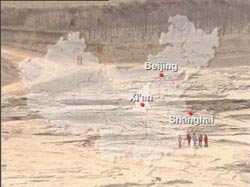

Welcome to this once-a-year celebration at Lantern Festival in Yan'an City. In this episode, you will see a lot of singing and dancing, a lot of people and a lot of the color red, which has a special meaning here.
This is the land that has nurtured and generated a Chinese culture that dates back as early as five thousands years ago. Here is where we find the earliest traces of civilization in China. Here is where culture and imagination roam free and unrestricted, and are best expressed in the paintings done by the local farmers and traditional paper cutting. Life here is incredibly loaded with traditions that go back beyond living memory. Once you get here, you will soon adjust to the dry looking yet actually very fertile landscape. In fact the dry climate is one reason why the region produces very sweet fruits. It draws the sugar into the fruit. And it seems to have a similar effect on people.
|
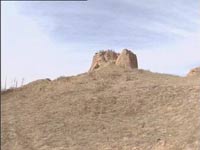
|
|
|
The city of Yan'an is also nationally famous for its special significance in China's Revolution. It was the final destination of the legendary Long March, the expedition of over 25,000 li, or roughly 8,000 miles made by the Chinese Red Army. For thirteen years, until the founding of the People's Republic of China in 1949, the Communist Party of China stationed its seat around Yan'an.
Today Yan'an is very much a tourist and market center nestled amid the earthen hills. It is not very big. But it is prosperous. Many have benefited much from the riches of the surrounding oil fields.
As a tourist center, a national travel destination, Yan'an has the services to carry you anywhere. I struck a deal with the driver, paying 100 yuan to get to Ansai, which is about half an hour drive from the city center. I was not quite sure what I would find there. In the big cities, the festivals are getting more and more commercial and families tend to celebrate among themselves. But I have a firm belief that the people here take the festivals much more seriously than the urban dwellers. A community spirit prevails here and people like to celebrate the seasonal rituals in big crowds. Around this time, there are shows organized throughout the region for the entertainment that is a big part of the celebration. But this one is specially arranged, on a special stage.


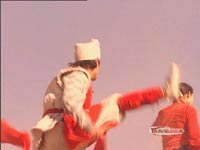
The fine yellow earth hill is their stage. Some two hundred photographers from all over China have made a special trip here for this show. And they are not disappointed. The dance is visually stunning. The bright colors of the dancers' costumes, the blue sky as the backdrop and the fine yellow earth swirling like a thin golden fog at the dancers' feet have driven the photographers wild. This is called the Ansai Drum. It has been christened the Drum of Victory, for its boisterous and uninhibited spirit. And for a moment here, I get the feeling that these dancers have been dancing, suspended here between blue sky and the yellow earth, from the beginning of time. The drum dance originated in the ancient rituals of ancestor worship and has gradually evolved into a kind of celebration.
There is a particular kind of drum named after this county, Ansai county. It's called the Ansai drum. Most of the people here can play it, the kids, boys and girls as well, start to learn it as early as seven or eight. But I went to visit Cao Zhuang village looking for an old man called Gao Chengzhi who is supposed to be the best drummer in the region. Walking along the earth tracks I discover that the village consists mainly of cave dwellings, and before we reached the old man's home, my attention is caught again by another extraordinary little performance. In this small room built into the hill, a local singer is giving a performance of Sanxian. Sanxian literally translates as "three strings" and it's a string instrument popular only in this region. I don't quite understand the local dialect, but I can see this is an ancient entertainment, a dramatic mix of singing, jokes, rhyming prose, folklore and stories, some pieces improvised, others obviously well known. Most of these performers are like specialists on call. They tour around festival times at special request, glad to get some extra money and display their talents. And they travel light. All they need is their Sanxian and the set of wooden pads they use to that clap out the rhythms.
|
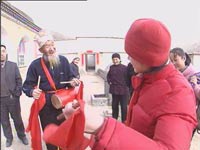
|
|
|
If only you can master the rhythm, you too could have a try at being a professional troubadour.
The tradition here is that, around festival time, people make various kinds of little shapes out of wheat flour dough. It seems they follow a traditional pattern to make all kinds of things and animals, such as birds, chicken, fish, tiger, and flowers. All have auspicious meanings.
Making Mian Hua, literally translated as the flower of wheat flour, is very much women's work. It's interesting to note they use everyday tools, usually very "womanly" things, such as scissors and combs. After a couple of minutes steaming, these little edible works of art are colored in certain patterns.
After these pleasant diversions, we finally arrived at our original destination, the home of the drum player. I followed the sound of a drum to the old man Gao's home. It seems the old man is practicing for the grand parade tomorrow. And after watching it for a while, I can't help asking for a bit of free tuition. First of all, you've got to have the drum tightly tied to your waist. This is essential so that it won't come off when you dance, or jump around. After that, the first step is, of course, to master the beat. Obviously, when the drum is playing, the old man's spirit soars. Despite the physical demands of drumming and dancing it is clear that this 69-year-old enjoys it tremendously.
|
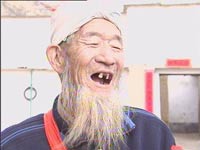
|
|
|
Gao Chengzhi, 69-year-old drum player, said to us,"You've got to swing your arms around so you can play the drum from both sides. It鈥檚 really difficult to play it well. When you play the drum, you get the feeling the drum raises people's spirit, you feel so happy playing it. --Of course, if you want to play it well, you've got to master seven or eight different beats. You can't get a good dance rhythm going with only the basic beats. You need seven or eight different beats working with one another to make an excellent dance."
Maybe it's the vast loess plateau that has nurtured the straightforward and warm hearted character of these people just as it adds that special sweetness to the local fruit. But once you play and hear the sound of the drum, you realize their enthusiasm and bursting warmth is infectious.
This is really so exciting and exhausting. There is no way that I would learn this drum in a couple of minutes, but I really get to feel the warm atmosphere and the sense of festivities around here.
Now let me take you a little tour around these marvelous cave homes. This is one bedroom and this is the main entrance to the homes and right opposite to the entrance is the kitchen. Let's see what we have here for dinner. It's too early yet. Anyway, while people cook the dinner, the energy and heat are not wasted. It goes through here to the bed in the bedroom. And keeps you cozy in wintertime.
It is around this time of the year that every family spring cleans the house and hangs up the red lantern. The color red is used to decorate the homes and express the people鈥檚 feeling for the NEW YEAR, just the same as the decorations on the Christmas trees, I guess. Another thing they do is a paste paper cutting on the windows. In the olden days, when the windows were covered with paper, these paper cutting would provide an opulent silhouette. But these days, glass is used more and more for windows, and gluing the paper cutting to the glass, well, that's how tradition evolves. Another evolving thing is the food here. The grand festival dinner here traditionally consists of eight courses, all meat, no vegetables. If you were a vegetarian you'd have a problem with the festival cuisine here. The eight set courses would definitely include fish, pork, mutton, and chicken. And, just as they do for any big occasion, dumplings complete the picture. Guess what people wrap inside these dumplings?
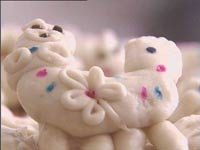
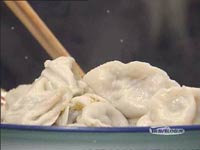

When dinner is ready, the family sits on the Kang, the big fire heated bed around a small table for the grand meal. To gather around the table and have dinner is a warm symbol of family union and the more family members that turn up, the more "rounded" the family is, which translates as 鈥漰erfect". The meat courses were served as a festive treat in the old days. These days they simply symbolize a little extravagance for the celebration. During this meal, I was surprised to discover that the Chinese Han people are very artistically talented. Unexpectedly, the shy-looking 9-year-old grandson gave a performance mimicking a trumpet with his own mouth!! After that, the old man, the drum player sang a song called the Wine Song. It's the special song to be sung at the occasion to encourage people's spirit for drinking!! The Lantern Festival happens during the first full moon of the Chinese New Year, when the bright light of the big round provides a solid reason to celebrate. Around this part of China, people have a tradition of jumping through a bonfire to get rid of all the bad luck for the past year and get good luck for the coming new year. Every family member needs to do this, and. it's quite a game.
On the fifteenth of the first month of Chinese New Year, people started to gather in the City of Yanan for the once a year parade show.
This has always been the most exciting day in Yanan. Performers from nearby regions will all gather here and so will the spectators. Tens of thousands are expected to show up and watch the parade show along the road.
The atmosphere is charged with expectation and excitement. The show doesn't officially begin until eleven o'clock, but people are waiting along the road as early as nine o'clock.
Each year on this day the local people have carefully planned and organized a large-scale performance and they invite players from nearby counties to give a grand show. Each region tries to rival the others and put on the best possible show. My guess is that for these local people, such a show is more or less routine as they see it every year, and there is not much change from year to year, as these are the most traditional dances in the region. But for me, an outsider, it's quite a perfect joy to be here. The noise, the crowds, this is what I came here for!!! There I spotted my drum teacher who is too busy enjoying himself to notice me among the crowd.
It's been an hour now but I still don't see the end of the parade. They just keep coming one after another and each one seems better than the other. It' s totally great. This you can鈥檛 see at any big cities.
Still fresh from the excitement of the grand gathering, I set out to visit a road built by Qin Shihuang, the first emperor to open up and unite China. He built a number of roads throughout the country. This one was built to last with layers of stamped earth, limestone, each layer seven centimeters thick. This is one reason archeologists have decided this was a road built by Emperor Qin. The road was quite a project. It extends some seven or nine hundred kilometers straight north until the Great Wall in Inner Mongolia. Here near Yan鈥檃n, you can find traces of the road in Ganquan county.
See these marks? The stone was much bigger and when the road came over here. people cut the road into half and this is the half left, like a gigantic road curb.
Voice-over: The road was built as a military supply route, so it went in a straight manner with as few curves as possible. This was to ensure the fastest possible transportation of soldiers and supplies. The width of the road is between 20 to 30 meters. If you went further up the road along the traces, you would also find ancient village dwelling on remains of castles built for the soldiers and the emperor, who never made it along this road.
It's been two thousand years, there are really not much left to see. Anyway, the process of looking is still fun.
When American journalist Edgar Snow came over here half a century ago, he came with all the questions, what is this Red Army, who were their leaders. Today when I came here, those were no longer questions. But the sense of history making is still the same.
Between 1937 and 1948, Yan'an and the nearby region was the center of the Communist Party of China before the founding of the People's Republic of China in 1949. The Red Army emerged from the 8000-mile Long March and settled down here to establish their base. You can find well preserved homes here that used to accommodate such legendary figures as Mao Zedong, Zhu De and Zhou Enlai. Some of the furniture is the original stuff and some pieces are copies. But from these bits and pieces, you can get some idea of the austere lifestyle they led during those thirteen years, while they pursued their passion to build a better world.
Under strict economic difficulties, the red army, also known as the Eighth Route Army at the time, started a campaign called mass production. That means all soldiers participated in production and spinning, to ensure their daily supply. Even the high-ranking officials are no exception. Among all the other, Premier Zhou Enlai was best known for his excellent spinning skill.
It was a time of complete idealism. Officers and soldiers alike lived on rations. As Edgar Snow described, they lived on unimaginable small amount of supplies. Yet they stood proud and in good spirits.
Want to try a moment of being a red soldier? We have all the outfit here. And a pistol case, and a cap with a red star.
Another symbol of Yan'an is this Yan'an pagoda. In China, everyone knows it as a landmark of Yan'an, the base of revolution. But few people also know that it was an ancient pagoda built during Song Dynasty, nearly one thousand years ago. Today, on the cliffs at the foot of the hill, you can still find inscriptions done around that time by famous calligraphers.
I've known this pagoda since I was a kid but I never know it's hollow inside and you could actually climb in it like this.
The nine-floor brick pagoda was quite a climb. It was narrow inside. Finally I am here, I thought I'll never get here. You have a very nice view here, you could see pretty far. One hundred years ago I would volunteer to be a guard to watch out for the city here.
Yan'an means "extended peace". Since ancient times, Yan'an has been a major military stronghold. But people here no longer think about that, because war has faded into history and peace is the main theme of the day now.
Without a doubt, Yan'an takes a special position in Chinese history of revolution. At the same time, people here have maintained a deep rooted Chinese tradition. So if you want to catch both of it, better plan your trip around big festivals, like the Spring Festival or the Lantern Festival.
Editor:Zhang Source:CCTV.com